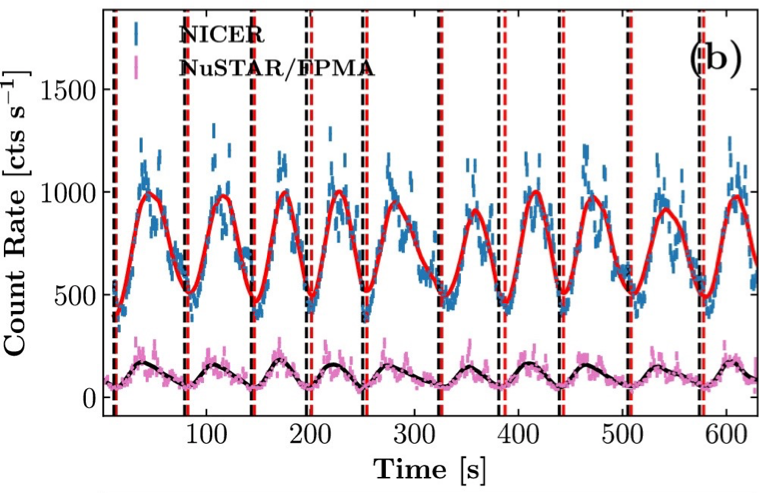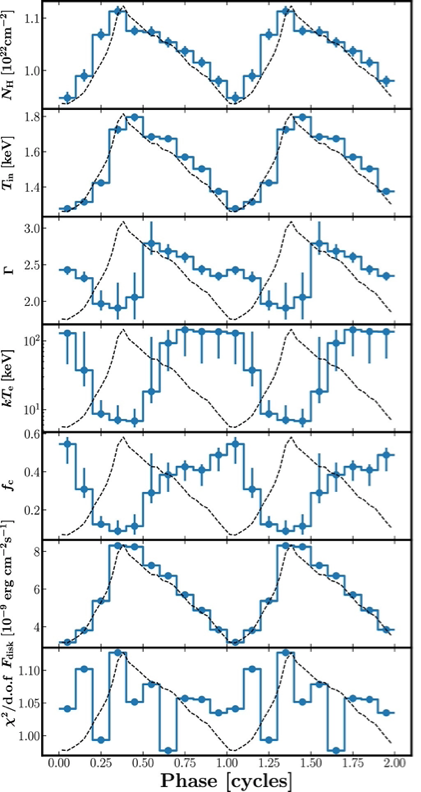NICER / ISS Science Nugget
for October 17, 2024
Dissecting a heartbeat
Of the hundreds of X-ray emitting binary systems known, only two are seen to exhibit the phenomenon known as "heartbeats": deep, repeating brightness fluctuations that follow patterns reminiscent of electrocardiogram traces from a human heart. The first known heartbeat source, the well-studied binary GRS 1915+105, historically has demonstrated 14 different-shaped heartbeat modes; unfortunately, GRS 1915 has been in an unprecedented dim state since approximately a year into the NICER mission (and the community eagerly awaits its return). The second system, IGR J17091-3624, was last seen in outburst in 2022, during which observations with NICER and NASA's NuSTAR telescope (sensitive to higher-energy X-rays) detected a previously unknown heartbeat mode, one of nine now categorized. Dubbed Class X, these oscillations change the overall system brightness by a factor of 2, recur with an approximately 70-second period, and are more regular and symmetric than other modes.
Both GRS 1915 and IGR 1791 are accreting black-hole binaries. Heartbeat oscillations are thought to arise as a result of a "limit cycle" phenomenon, in which matter flowing onto the black hole at a high rate produces radiation near the event horizon - at the inner edge of an accretion disk - so powerful that these emissions push back on the infalling matter, temporarily lowering the flow rate. As the energy available to the radiation dies out, the relentless flow eventually overpowers it and the cycle begins anew.
In a peer-reviewed paper recently published in The Astrophysical Journal, Qing-Cang Shui (Chinese Academy of Sciences, PRC) and collaborators describe analysis of the NICER and NuSTAR observations of the Class X heartbeat in IGR J17091. Using a numerical approach designed to deal with not-strictly-periodic phenomena, they examine how the X-ray emission varies with the heartbeat cycle in both low-energy (NICER) and high-energy (NuSTAR) X-rays. Specifically, they adopt models for the X-ray spectrum arising from thermal accretion-disk emission as well as nonthermal emission from a "corona" of hot plasma, in 10 time-slices across heartbeat phase. Their primary finding is that, at least for the Class X mode, the brightness oscillation is principally driven by the temperature of the gas in the innermost parts of the accretion disk, consistent with the limit-cycle hypothesis, but that some as-yet-unresolved process also alters the properties, to a lesser extent, of the corona, with the most notable consequence being a deficit of emission in the hardest X-rays visible with NuSTAR. Such time-resolved spectroscopy is a powerful tool for discerning, in real time, the physics of dynamic systems such as accreting black hole binaries.


Left: "Heartbeat" brightness variations of the black-hole-candidate binary system IGR J17091-3624, as measured with NICER (blue bars) and NASA's NuSTAR X-ray telescope (pink bars) in 1-sec intervals. Solid red and black traces are low-pass filtered representations of the measured fluctuations as derived from the numerical Hilbert-Huang Transform technique; vertical dashed lines are the HHT-inferred trough times. (Credit: Qing-Cang Shui et al. 2024)
Right: For one of two spectral models adopted by the study authors, each panel represents the evolution - across the averaged heartbeat behavior (NICER "lightcurve" in the dotted black trace) - of a model parameter. From top to bottom, these are: line-of-sight density of X-ray absorbing material; temperature of the inner part of the accretion disk; spectral slope of nonthermal emission; temperature of electrons in a hot corona; geometric covering fraction of absorbing material; total flux of emission from the disk; and "chi-squared" goodness-of-fit statistic. Evident trends include a strong correlation of the heartbeat brightness with disk temperature (2nd panel), and anti-correlation with the nonthermal emission (3rd panel). (Credit: Qing-Cang Shui et al. 2024)
<< Previous
Main Index
Next >>